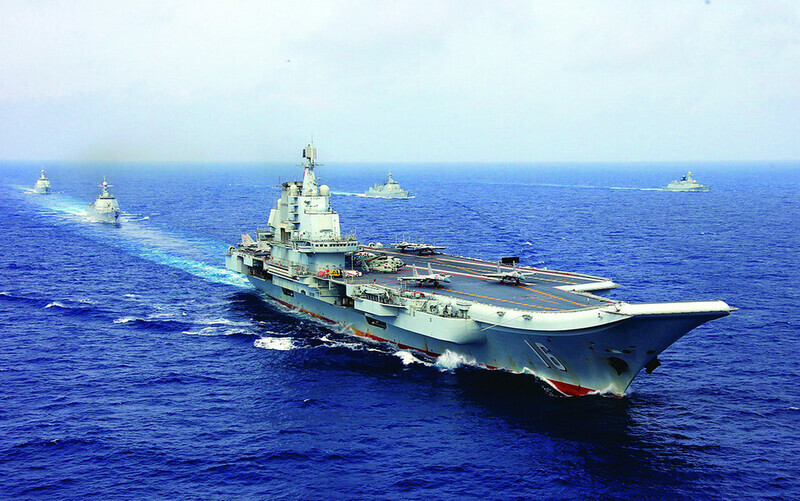hankyoreh
Links to other country sites 다른 나라 사이트 링크
[column] China’s war of financial attrition against Taiwan

“It was supposed to be Hainan and then Taiwan. If Kim Il-sung had moved just a little more slowly, history would have turned out differently,” said a Chinese foreign policy and security expert I met not long ago. His remarks represent the mainstream Chinese viewpoint on the Taiwan question.
The Chinese Civil War didn’t end with the establishment of the People’s Republic of China (PRC) on Oct. 1, 1949. On Mar. 5, 1950, the forces of the Communist PRC launched a campaign against the Nationalist Kuomintang on the island of Hainan, in the South China Sea. The Communist campaign ended on May 1 when the surviving Nationalists withdrew to Taiwan. Fifty-five days later, the Korean War broke out.
At first, the US had no intention of getting involved in Taiwan. On Jan. 5, 1950, US President Harry Truman announced that the US wouldn’t intervene in an armed attack by Chinese forces on Taiwan, then known as Formosa. But he changed his attitude shortly after the outbreak of the Korean War. In a statement on June 27, 1950, Truman emphasized that “the occupation of Formosa by Communist forces would be a direct threat to the security of the Pacific area and to United States forces.”
American firepower had begun to concentrate around the Korean Peninsula, on the front lines of the Cold War. Truman quickly had the US 7th Fleet deployed to the Taiwan Strait, where it would prevent Chinese troops from crossing over to Taiwan.
The Chinese Air Force was established in November 1949. The first Chinese flight group had been set up four months prior to that, back in July. The flight group consisted of just six P-51 Mustang fighters, two DH-98 Mosquito bombers, and two PT-19 Fairchild trainer aircraft. What does Chinese air power look like today, 70 years later? The US Department of Defense’s yearly “China Military Power Report,” released on Sept. 1, said that China’s air force is the third most powerful in the world, after the US and Russia.
Today, Chinese air power includes 1,500 fighters, 450 bombers, 400 transport aircraft, and 150 special-purpose aircraft, including surveillance planes. In contrast, the Taiwanese military only has 400 fighters, with not a single bomber. As for transport aircraft and special-purpose aircraft, Taiwan only has 30 of each. Numerically speaking, China holds overwhelming air superiority, at a ratio of 2,500 to 460.
On Oct. 1, as mainland China was entering a long eight-day holiday to mark the 71st anniversary of the PRC’s founding, a Chinese Y-8 antisubmarine patrol aircraft crossed the southwestern border of Taiwan’s air defense identification zone (ADIZ). The same aircraft flew along a similar flight path on Oct. 3, Oct. 4, and Oct. 6. Then on Oct. 7, a Chinese KJ-500 airborne early warning and control (AEW&C) aircraft flew across the southwestern edge of Taiwan’s ADIZ. During each incident, the Taiwanese Air Force scrambled patrol planes and asked the Chinese military aircraft to withdraw over radio while also activating its ground-based anti-aircraft missile system to track the trespassing aircraft.
China crossed median line in Taiwan Strait 49 times in 2020, costing Taiwan 8.7% of its military defense budgetIn a briefing to the foreign policy and defense committee of Taiwan’s Legislative Yuan on Oct. 7, Taiwan Defense Minister Yen The-fa said that the Chinese military had made 219 incursions into Taiwan’s southwestern ADIZ this year alone. Furthermore, Yen said, Chinese forces had crossed the median line in the Taiwan Strait, which functions as an air and maritime boundary between China and Taiwan, on 49 occasions — the most since 1990, three decades ago.
Taiwanese fighters had to scramble a total of 2,972 times in response, and Taiwanese naval vessels were also hurriedly dispatched. Taiwan’s Central News Agency said that such military actions had cost its air force NT$25.5 billion and its navy NT$5.7 billion, for a total of NT$31.2 billion, or more than US$1 billion. That accounts for 8.7% of Taiwan’s defense budget this year.
“Once the PLA [People’s Liberation Army] warplanes cross the center [median] line, it only takes 200 seconds to reach the nearest point on our coastline,” Wang Kung-yi, chairman of the Taiwan International Strategic Study Society think tank, told the South China Morning Post on Oct. 3.
When Chinese forces cross the line, the Taiwanese military is obliged to respond. The more frequently the line is crossed, the greater the cost incurred. Perhaps that’s exactly what China is aiming for.

By Jung In-hwan, Beijing correspondent
Please direct comments or questions to [english@hani.co.kr]

Editorial・opinion
![[Guest essay] Preventing Korean Peninsula from becoming front line of new cold war [Guest essay] Preventing Korean Peninsula from becoming front line of new cold war](https://flexible.img.hani.co.kr/flexible/normal/500/300/imgdb/original/2024/0507/7217150679227807.jpg) [Guest essay] Preventing Korean Peninsula from becoming front line of new cold war
[Guest essay] Preventing Korean Peninsula from becoming front line of new cold war![[Column] The state is back — but is it in business? [Column] The state is back — but is it in business?](https://flexible.img.hani.co.kr/flexible/normal/500/300/imgdb/original/2024/0506/8217149564092725.jpg) [Column] The state is back — but is it in business?
[Column] The state is back — but is it in business?- [Column] Life on our Trisolaris
- [Editorial] Penalties for airing allegations against Korea’s first lady endanger free press
- [Editorial] Yoon must halt procurement of SM-3 interceptor missiles
- [Guest essay] Maybe Korea’s rapid population decline is an opportunity, not a crisis
- [Column] Can Yoon steer diplomacy with Russia, China back on track?
- [Column] Season 2 of special prosecutor probe may be coming to Korea soon
- [Column] Park Geun-hye déjà vu in Yoon Suk-yeol
- [Editorial] New weight of N. Korea’s nuclear threats makes dialogue all the more urgent
Most viewed articles
- 1Yoon’s broken-compass diplomacy is steering Korea into serving US, Japanese interests
- 2[Guest essay] Preventing Korean Peninsula from becoming front line of new cold war
- 3[Column] Why Korea’s hard right is fated to lose
- 4S. Korean first lady likely to face questioning by prosecutors over Dior handbag scandal
- 5[Guest essay] Maybe Korea’s rapid population decline is an opportunity, not a crisis
- 6After 2 years in office, Yoon’s promises of fairness, common sense ring hollow
- 760% of young Koreans see no need to have kids after marriage
- 8[Column] The state is back — but is it in business?
- 9[Editorial] Penalties for airing allegations against Korea’s first lady endanger free press
- 10Why Kim Jong-un is scrapping the term ‘Day of the Sun’ and toning down fanfare for predecessors